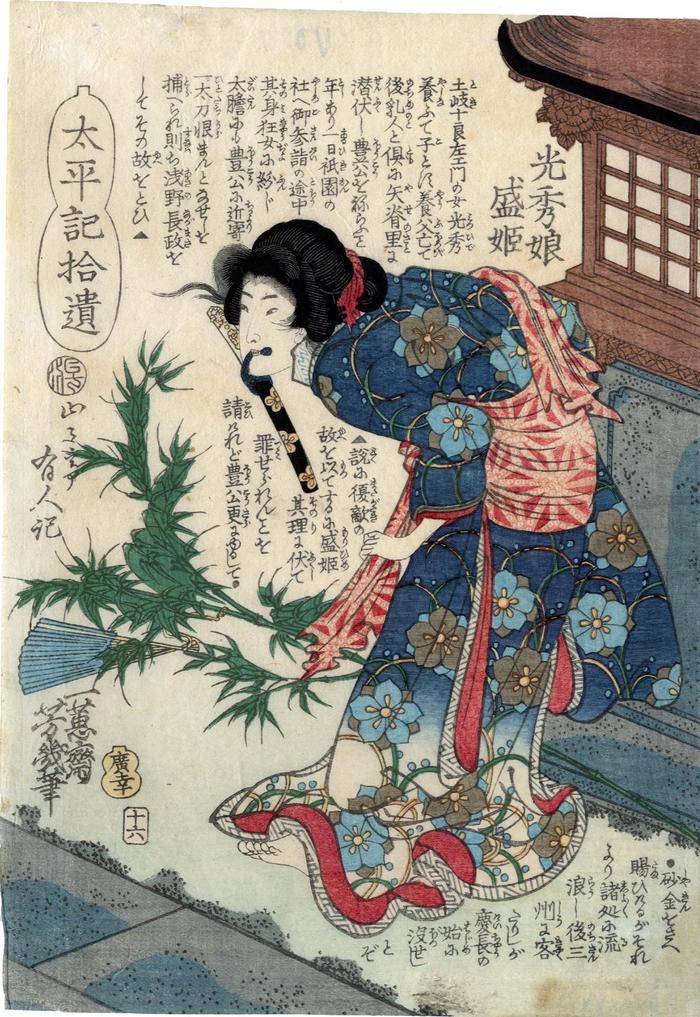Utagawa Yoshiiku (歌川芳幾 - 1833-1904) (artist )
Mitsuhide's daughter, Morihime (Mitsuhide musume Morihime - 光秀娘盛姫) - number 16 (十六) from the series Taiheiki Supplements (太平記拾遺)
10/1869
6.5 in x 9.5 in (Overall dimensions) Japanese color woodblock print
Signed: Ikkeisai Yoshiiku hitsu
一恵斎芳幾筆
Publisher: Hirookaya Kōsuke (Marks 117 - seal 12-059)
Date and censor's seal combined: 1869, 7th month and aratame
Number 16 (十六)
Tokyo Metropolitan Library
British Museum - an 1820 Kunisada print of an actor as Morihime Notice that Morihime is holding a cord in her teeth from which dangles a sword still encased within its scabbard.
****
Morihime, sometimes spelled Mori-hime was the daughter of Akechi Mitsuhide (明智光秀), who was the killer of Oda Nobunaga in 1582. Mitsuhide in turn was killed by Hideyoshi. We can identify this figure as a member of the Akechi Mitsuhide's Toki clan by the bellflower emblems decorating her kimono. The bellflower or kikyō (桔梗) is referred to as the Platycodon grandiflorum in Latin.
****
The historical Akechi Mitsuhide
Elena Varshavskaya wrote: "On the 2nd day of the 6th month of the 10th year of the Tenshō era (21 June 1582), the warlord Oda Nobunaga, who controlled about one third of Japan, was attacked by his vassal Akechi Mitsuhide at the Honnōji temple in Kyoto. Overwhelmed by the larger forces of the attackers, Oda Nobunaga met his fate amidst the burning ruins of the temple. Akechi was not the only one to turn against his master. In Japan in the 16th century, as regional lords fought for political supremacy over the entire nation, such acts of treachery were common occurrences. Akechi's assault was different because it resulted in many significant changes in the political landscape of Japan. Nobunaga's death opened the way for Toyotomi Hideyoshi, another of his vassals, to establish hegemony over Japan. Hideyoshi, a samurai of modest origin, was endowed with extraordinary talents both as a military commander and as a politician. On joining Oda Nobunaga's service, Hideyoshi quickly became his trusted vassal. By the time of Nobunaga' s sudden death, Hideyoshi was one of the most powerful warlords and influential political figures in Japan. The news of the fatal events in Kyoto reached Hideyoshi when he was fighting far away in the western part of the country. Understanding that an immediate victory over the 'traitor' would dramatically increase his chances of becoming Nobunaga's political heir, he hastened back to the capital. Eleven days after the Honnōji affair, Hideyoshi completely routed Akechi, who was killed by villagers as he fled the scene of the battle."
Note that the curatorial files at the British Museum state: "Mashiba Hisayoshi was the name used by kabuki theatrical convention for the character Hashiba Hideyoshi, that is, the military leader Toyotomi Hideyoshi (1536–98)." Takechi Mitsuhide is actually Akechi Mitsuhide.
Hirookaya Kōsuke (広岡屋幸助) (publisher)
warrior prints (musha-e - 武者絵) (genre)
Taiheiki (太平記) (genre)
